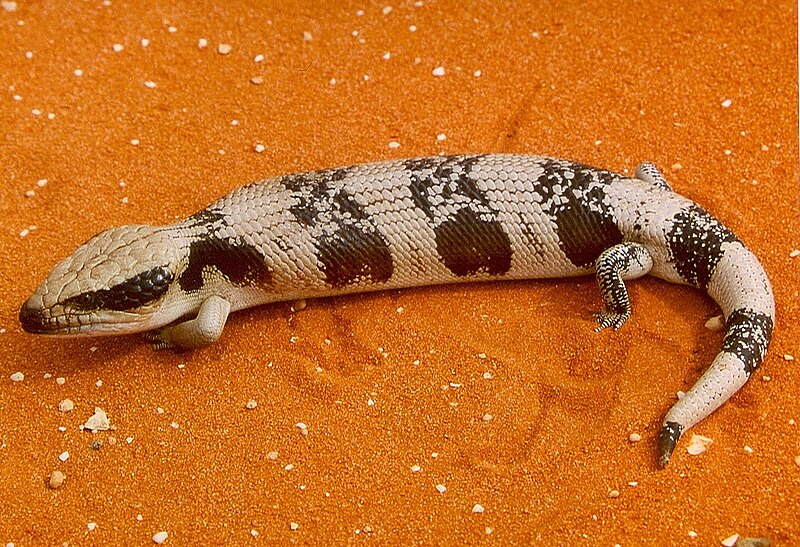 We are fortunate indeed that 2 species of huge, interesting Blue Tongue Skinks (Tiliqua gigas and T. scincoides) are well established in the trade and relatively hardy (captive longevity approaches 30 years) in captivity. Inquisitive, handle-able and with easily met dietary requirements (live insects not needed!), Blue Tongues are becoming ever more popular among lizard fanciers.
We are fortunate indeed that 2 species of huge, interesting Blue Tongue Skinks (Tiliqua gigas and T. scincoides) are well established in the trade and relatively hardy (captive longevity approaches 30 years) in captivity. Inquisitive, handle-able and with easily met dietary requirements (live insects not needed!), Blue Tongues are becoming ever more popular among lizard fanciers.
Which Skink is Which?
Blue Tongue Skink taxonomy is somewhat confusing, with pet trade names, hybrids and captive bred color phases (i.e. orange, “sunglow”) complicating matters. Three subspecies of both Tiliqua gigas and T. scincoides are recognized, and all seem to hybridize readily. T. gigas, often referred to as the Giant or New Guinea Blue Tongue Skink, hails from Indonesia and New Guinea (including offshore islands). T. scincoides goes by numerous common names, and occurs mainly in Australia, with one subspecies on some Indonesian islands.
Enclosure
An adult should be provided with a terrarium of at least 48” x 24” – roughly the size of a 55 gallon aquarium. In addition to allowing for a variety of interesting behaviors, a large cage will enable you to provide a thermal gradient, which is important to the long-term health of most reptiles. Although not well-adapted for climbing, the skinks will use vertical space in the form of gently sloping rocks and thick limbs. Place rocks on the tank bottom rather than on the substrate, lest the skinks burrow below and become crushed.
Humidity
Cypress mulch makes a good skink substrate and allows for easy spot-cleaning – just be sure it does not become damp. Most Blue Tongue Skink populations inhabit semi-arid habitats, and in captivity they are prone to bacterial/fungal skin infections if kept in overly moist surroundings. A moist retreat, however, is essential – a cave provisioned with dampened sphagnum moss serves well.
The terrarium should also be misted lightly with water once daily – just enough so that it dries out within 30 minutes or so.
Shedding Concerns
Although adapted to dry climates, Blue Tongues are often plagued by “dry sheds” in captivity. Old skin often sticks to the tail tip, toes and around the eye, which accounts for the frequency of missing digits and tail-tips among pet skinks. Be sure a sturdy water bowl, large enough for allow for soaking, is available at all times. Skinks that have trouble shedding can be soaked overnight in a few inches of warm water and assisted with a Reptile Shedding Aid.
Light and Heat
 A basking site of 95F or so should be provided, with an ambient temperature of 82-85 F. A nighttime dip to 68-72 F is beneficial.
A basking site of 95F or so should be provided, with an ambient temperature of 82-85 F. A nighttime dip to 68-72 F is beneficial.
Blue Tongue Skinks can utilize dietary Vitamin D3, and consequently have been raised successfully without access to UVB light. A safer option, however, is to provide your skinks with a UVB emitting bulb – I recommend a Zoo Med 10.0 positioned approximately 12 inches from the basking site.
A UVA source, while not essential, is useful in promoting normal activity and breeding behavior. Concerning breeding, there are some difficulties, as Blue Tongues are best kept alone. Adults are quite unsociable, and fighting is common regardless of sex and season. Please see Part II of this article for details.
Further Reading
Please see this Bishop Museum Field Report for information on wild Blue Tongue Skinks and other herps of New Guinea.
This Video clearly illustrates how tame and curious these lizards can be.
T. nigrolutea image referenced from wikipedia and originally posted by noodlesnacks
 That Reptile Blog – Reptile, Amphibian and Exotic Pet Care and Information
That Reptile Blog – Reptile, Amphibian and Exotic Pet Care and Information


